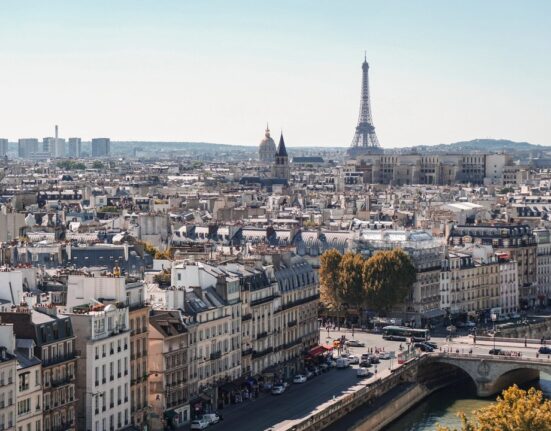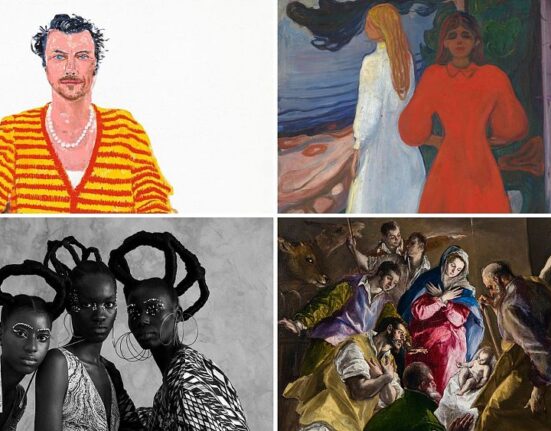At the MFAH, the newest fine art is mix mastery
It looks like DJs with exquisite taste have been sampling the old stuff at the Museum of Fine Arts, Houston.
Away from the new Kinder Building’s modern and contemporary collections and hot-ticket temporary exhibitions, a quiet revolution has been rippling across the campus.
Advertisement
Article continues below this ad
The MFAH, which will be 100 years old in 2024, seems to have found a new groove with a more dynamic, organic — and shall we say, 21st century — approach to displaying historical works. Sharing works from across departments, the museum’s curators have rebooted five permanent collections, masterfully integrating more media to convey deeper, more engaging stories.
Eleven galleries of Medieval and Renaissance paintings are the latest to get the treatment. The transformation is so dramatic it feels like a whole new experience, bringing sumptuous tapestries and other textiles, decorative objects, devotional art, books and works on paper into view alongside paintings.
Some of the MFAH’s Old Master paintings have been fixtures since 1944, when Macy’s magnate Percy Straus donated more than 80 magnificent 13th and 14th century Italian works. Including Fra Angelico’s powerful little “Saint Anthony Abbot Shunning the Mass of Gold” and numerous gold-ground paintings (devotional portraits set against backdrops of pure gold leaf), Straus’ gift formed the nucleus of the European collection.
Smaller leaps came after the Beck building opened 22 years ago, with rooms to fill. Rembrandt’s moody, high-contrast “Portrait of a Young Woman,” luscious Dutch still lifes and Diego Velázquez’ “Kitchen Maid” (which was discovered behind a door at Rienzi in 2018) have been draws for a while now.
Advertisement
Article continues below this ad
To move beyond that stricter picture story, curators Christine Gervais and James Anno didn’t simply add a few related objects. They created thoughtful displays that, while still classical, bring viewers a step closer to full immersion.
The size and shape of the galleries hasn’t changed, but color-coded walls now denote shifts in time, geography and themes. A few floating walls mask the distraction of exit doors. And things come to light in the sight lines between rooms. “We wanted there to be a rational, discernable itinerary from one gallery to the next,” Anno said. “Curating a single room is fine, but that has to somehow relate to what you walk into next.”
New acquisitions and long-term loans advance the narratives, but also shopped the MFAH closet, seeking the best objects that made the most sense with the paintings they had.
“We can draw across our entire holdings and pull things out that have never been seen before,” Anno said. “We have things that haven’t been seen in decades. And then we have the greatest hits.” The reinvented galleries hold about 35 percent more material.
Advertisement
Article continues below this ad
Bringing culture into the equation
The practice of segregating artworks by type or technique originated in Europe hundreds of years ago, when the great museums of the world were founded for artists, researchers and connoisseurs, said MFAH director Gary Tinterow. “Now that we have embraced ever-widening audiences, it makes sense for us to create displays with the full variety of artistic expression in each culture.”
Curators elsewhere have taken notice of the MFAH’s successful reinstallations. In Naples, Italy last week, Tinterow was pleasantly surprised to discover a just-finished gallery that’s a test display for the future re-installation of the entire collection at the Museo di Capodimonte. “It looked very much like our new galleries for European art,” he said.
The MFAH has long prided itself on being a museum for all people. It’s grown into its britches as an encyclopedic institution — one that teaches visitors about the full scope of civilized culture, from antiquity to the present — through decades of strategic collecting nurtured by major donors.
The museum now owns more than 70,000 objects, a number that grows every year. (More than 1,300 new pieces, including purchases and gifts, were acquired in 2021.) Yet in historical collecting areas such as the Medieval and Renaissance periods, the MFAH will never have the same critical mass of works you’ll find at, say, New York’s Metropolitan Museum of Art and other older institutions that were in the collecting game decades earlier.
Advertisement
Article continues below this ad
The new approach to curation makes that less of a handicap, and maybe even a blessing: A mixed display can immerse visitors without overwhelming them. The 200 works on view are organized into nine sections, some of which span multiple galleries.
Among the new acquisition and loan highlights, in chronological order:
- The large, glistening tondo “The Madonna in Adoration of the Christ Child Surrounded by Angels, with God the Father” — a treasure that was recently discovered in a French villa and is on display in a museum for the first time. It’s by the 15th century craftsman Andrea della Robbia, whose family pioneered the technique of polychrome glazed terracotta.
- An early 16th century stained glass window from Germany.
- A late 15th century bust of Christ by Andrea del Verrocchio, Leonardo da Vinci’s teacher, that may have inspired the Christ figure of da Vinci’s famous “Last Supper” fresco. Designed for a sculpture above a cathedral door, it’s displayed for the first time as it was meant to be viewed — so Christ is gazing sadly down at you.
- A copy of the Nuremberg Chronicle, the world’s first illustrated encyclopedia, published in 1493.
- Two sumptuous tapestries that would have cost more in the 16th or 17th century than any of the other objects on display. One is Flemish, one is French. The latter combines wool with silk threads intended to glisten in candlelight amid a lot of other sparkling furnishings.
- Insanely detailed portrait miniatures. “Portrait of a Young Nobleman” is the work of Isaac Oliver, one of England’s best painters of the early 17th century. The extremely rare “Henri III, King of France,” depicting a controversial 16th century monarch who dolled up as a woman. It’s the only known work bearing the signature of the royal painter Jean de Court.
- An intricately inlaid late 17th century long-case clock, attributed to André-Charles Boulle, the cabinet maker to King Louis XIV.
- *A 25-foot long biombo, or lacquered folding screen, with a finely detailed panoramic view of street life in 18th century Mexico City.
Recreating a Rennaissance gallery
Multiple themes merge in long, magnificent central gallery, which evokes a grand salon in an Italian palazzo. Like a museum-within-the-museum, it illustrates how a Roman art collector would have displayed his prize possessions. Along with supporting his era’s contemporary painters, he might also have funded archaeological digs across the city. The Classical sculptures that were being unearthed also fed the imaginations of artists, often serving as figure models for their paintings. The room’s portraits and Flemish tapestry also signal a move toward more secular art that took hold during the Renaissance, after several centuries when most art patronage came from the Catholic Church.
Advertisement
Article continues below this ad
Speaking of which — the Straus Collection’s masterpieces, which in the past have been scattered, are now corralled in a jewel box of a room, but not alone. Some of them flank an early 16th century Flemish chasuble (a priest’s vestment) and a glass case of shiny ecclesiastical objects. Gazing at it all, a visitor better understands how these things operated within the same cosmos. I could almost imagine I was attending Mass in a Gothic cathedral 500 years ago.
Acknowledging the colonialism that later fed opulent European lifestyles was an imperative, Anno said, but he and Gervaise didn’t want to impose that narrative, instead aiming to let the artworks “lead the conversation.”
For example, the museum’s nice collection of Dutch master paintings tell a story of global trade riches, displayed in a beautiful room with a table and the kind of decorative objects that appear in the still lifes. Glazed terracotta chargers and a small sculpture of a Trinitarian friar add a layer to new arrangements of Viceregal and Colonial art, discreetly reminding viewers that before the Spaniards colonized the Americas, their own homeland was ruled for 700 years by Moors.
The last great surprise is the aforementioned biombo, which likely was inspired by Japanese screens coming from Manila and painted by indigenous Central American artisans —“so you have the whole world on a platter,” Anno said. He and Gervais have divided the adjustable screen in half to put viewers in the middle of the scene. I could have lingered there for hours, examining the finely detailed buildings, the distant mountains and villages, the fantastical birds flying overhead and — most intriguingly — the diversity of the vendors, customers and other people mingling in the streets.
Gervais collaborated with another colleague two years ago a similarly-scaled reinvention of the museum’s American art collection. “It was interesting to see how people responded,” she said. “Traditional picture galleries have a particular feeling and tone and presentation. When you start to add in costume, textile, books, do people like it or not? In Houston, people really do like it. They like the different textures, the different stories, the idea of how people used things or what they wore or what they prayed to. These are experiences we can give to people.”
Reinstalled European Art Galleries
Where: Museum of Fine Arts, Houston Beck Building, 5601 Main
When: 11 a.m.-5 p.m. Wednesdays, 11 a.m.-9 p.m. Thursdays, 11 a.m.-6 p.m. Fridays-Saturdays, 12:30-6 p.m. Sundays
Details: General admission $12-$19, free on Thursdays; 713-639-7300, mfah.org







